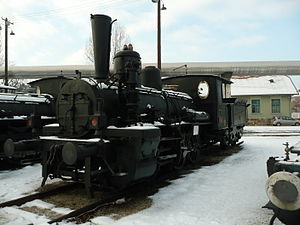MÁV Va
| MÁV class Va MÁV 370 CFR 370 SHS-370 JDŽ 120 HDŽ 120 JŽ 120 |
|
|---|---|
| Number: | 139 |
| Manufacturer: | MÁVAG , Budapest |
| Year of construction (s): | 1898-1908 |
| Retirement: | MAV: around 1950 |
| Axis formula : | Cn2v |
| Gauge : | 1435 mm ( standard gauge ) |
| Length over buffers: | 12,820 mm |
| Height: | 3,850 mm |
| Fixed wheelbase: | 2,950 mm |
| Total wheelbase: | 8,660 mm |
| Service mass: | 51.7 t |
| Friction mass: | 30.6 t |
| Wheel set mass : | 10.3 t |
| Top speed: | 50 km / h |
| Indexed performance : | 580 hp |
| Starting tractive effort: | 59.5 kN |
| Driving wheel diameter: | 1,180 mm |
| Control type : | Heusinger |
| Number of cylinders: | 2 |
| Cylinder diameter: | 410 mm |
| Piston stroke: | 620 mm |
| Boiler overpressure: | 12 bar |
| Grate area: | 1.41 m² |
| Evaporation heating surface: | 92 m² (in contact with water) |
| Water supply: | 7 m³ |
| Fuel supply: | 3.2 t |
| Brake: | Handbrake block brake |
The MÁV series Va , from 1957 MÁV series 370 , was a tender locomotive of the Hungarian State Railways MÁV for mixed service on branch lines . It was developed from a similar locomotive of the Raab-Oedenburg-Ebenfurter Eisenbahn with a slightly larger drive wheel diameter.
history
139 units of this locomotive were built by MÁVAG , Budapest , between 1898 and 1907 . In addition to the Hungarian State Railways , such locomotives were also used by some private railways such as the Aradi és Csanádi Egyesält Vasutak (ACsEV). Characteristic of the locomotive was its two-axle tender, with which it was equipped until it was a museum locomotive.
The locomotives also got to Yugoslavia and Romania by assigning territories . The literature does not provide any information about the operating times.
The 7111 locomotive shown was in service with the Hungarian State Railways until around the 1950s . From 1959 to 1968 it was owned by a coal mine in Mecsek . Thereafter, it was from the Budapest railway depot reconstructed Landler and has since been at the Railway Park Budapest .
technical features
The locomotive was a two-cylinder compound locomotive. In contrast to many other locomotives from Hungary at the time, it had an inner frame. The engine was moved far to the outside, which gave the locomotive a restless run.
On a level stretch, it was able to transport 473 t towing load at 50 km / h.
The technical solution of the locomotive, especially the position of the fire box and the cylinder beyond the outer wheel sets, was considered outdated.
See also
literature
- General Directorate of MAV , Autonomous Department for Press, Advertising and Propaganda (Ed.): Railway nostalgia in Hungary . Hungaria Sport Egri Nyomda, Eger 902436.
- Mihály Kubinszky (Ed.): Hungarian Locomotives and Railcars , Akadémiai Kiadó, Budapest, 1975, ISBN 963-05-0125-2
- Tibor Wein: Railway Noise of the Past , Közlekedési Múzeum , Budapest



